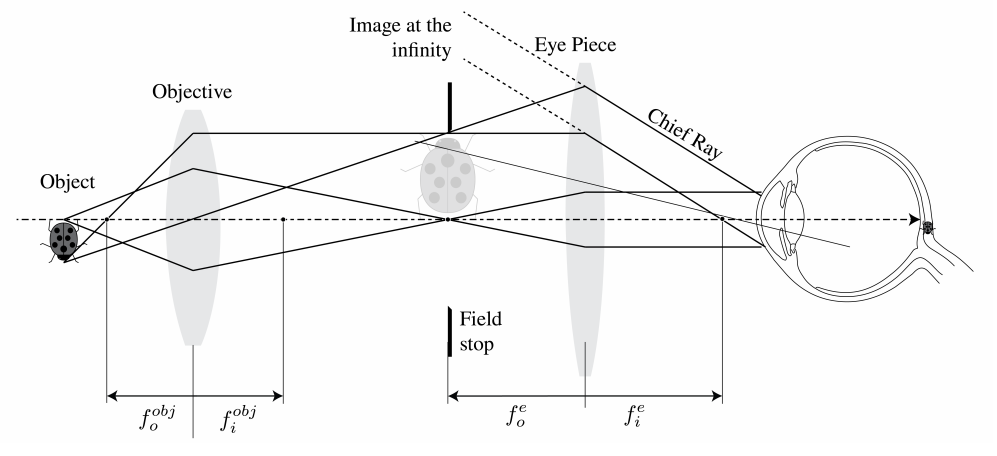3.8: The Compound Microscope
( \newcommand{\kernel}{\mathrm{null}\,}\)
A magnifier alone can provide very high magnification only at the cost of intolerable aberrations. The compound microscope is a magnifier of close objects with a high angular magnification, generally more than 30 \times. It was invented by Zacharias Janssen in Middelburg in 1590 (this claim is disputed). The first element of the compound microscope is an objective (in Figure \PageIndex{1} a simple positive lens) which makes a real, inverted and magnified image of the object in the front focal plane of an eyepiece (where there is also the field stop). The eyepiece will make a virtual image at infinity, as explained above. The magnifying power of the entire system is the product of the transverse linear magnification of the objective M_{T} and the angular magnification of the eyepiece M_{A e} : \mathrm{MP}=M_{T} M_{A e} . \nonumber

According to (2.5.51): M_{T}=-x_{i} / f_{i}^{o b j}, where x_{i} is the distance of the image made by the objective to its back focal plane with focal distance f_{i}^{\text {obj }}. We have x_{i}=L which is the tube length, i.e. the distance between the second focal point of the objective and the first focal point of the eyepiece. The tube length is standardised at 16 \mathrm{~cm}. Furthermore, according to (3.5.5), the angular magnification is for a virtual image at infinity M_{A e}=d_{o} / f_{i}^{e}. Hence, we obtain: \mathrm{MP}=\frac{-x_{i}}{f_{i}^{o b j}} \frac{d_{o}}{f_{i}^{e}}=\frac{-16}{f_{0}} \frac{25}{f_{e}}, \nonumber with the standard near-point d_{o}=25 \mathrm{~cm}. As an example, an Amici objective gives 40 \times and combined with a 10 \times eye piece one gets M P=400.
The Numerical aperture of a microscope is a measure of the capability to gather light from the object. It is defined by: \mathrm{NA}=n_{i m} \sin \theta_{\max } \nonumber with n_{\text {im }} the refractive index of the immersing medium, usually air, but it could be water or oil, and \theta_{\max }, the half-angle of the maximum cone of light accepted by the lens. The numerical aperture is the second number etched in the barrel of the objective. It ranges from 0.07 (lowpower objectives) to 1.4 for high-power objectives. Note that it depends on the object distance. In Chapter 7 it will be explained that NA is for the a given object distance proportional to the resolving power, which is the minimum transverse distance between two object points that can be resolved in the image.

